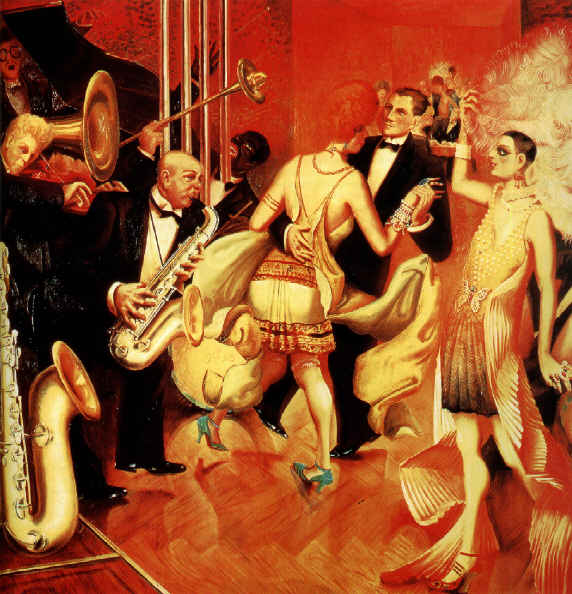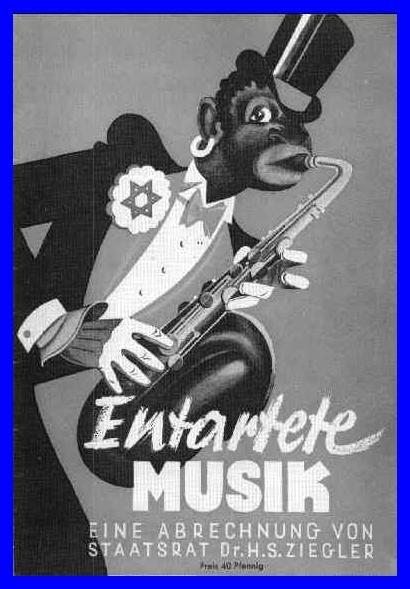 Centre Section of the triptych Grosstadt, 1927-8, by Otto Dix (1891-1969). It is an evocation of the Gershwin (1898-1937) period - the Jazz Age. This age and the kind of music (Jazz) were condemned by the Nazis as decadent and racially degenerate. 1 |
Degenerate Music
 Centre Section of the triptych Grosstadt, 1927-8, by Otto Dix (1891-1969). It is an evocation of the Gershwin (1898-1937) period - the Jazz Age. This age and the kind of music (Jazz) were condemned by the Nazis as decadent and racially degenerate. 1 |
Jewish musicians and composers, the atonality2 of Arnold Schoenberg, primitive Jazz, polka (pop music), cultural Bolshevism, and modern music (the avant-garde) were all considered degenerate music. What the Nazi set out to do was a 'contradictory musical revolution' where the old was brought back to replace the contemporary without at the same time creating new music that truly represented the National Socialist ideology.
In order to remove these degenerate musical elements from the music scene in Nazi Germany, the Nazis denied jobs in the music industry to the non-Aryans and especially the Jews, communists and those sympathetic to the former Weimar Republic. Progressive musical publications were banned and the avant-garde music makers were attacked in various ways. The establishment of the Reichmusikkammer was to centrally control all elements of music. Ruthlessness in the process of purging and removing undesirable music was dismissed as necessary.3
Besides controlling and purging, the Nazis also used exhibition to educate the public about degenerate music, and what were considered to be 'politically unlistenable'. All areas of music were covered in the Degenerate Music Exhibition, 'from composition and performance to education, musicology, criticism, and promotion'.4 Needly to say, Schoenberg and his atonality, jazz, anything associated with the Jews, modern and avant-garde music were all exhibited and viciously attacked. What was surprising was that the hatred for the Jews were so strong that even those 'Aryan' musicians such as Fritz J�de who had worked with and supported the Jews were attacked in the Degenerate Music Exhibition as well.5
Jewish musicians were most harshly purged in the Nazi era. In fact, the proponent of anti-semitism came not from the Nazi party but from the musicians themselves. Although Wagner had embraced racialist prejudices against the Jews, he was not anti-semitic.6 This latter fact was ignored by the Nazis and they twisted Wagner's thought in favour of the Nazis' anti-semitic stance. The most vociferous of all composers in the 1920s in music redemptive qualities was Hans Pfitzner. He warned that the disintegration of tonality - dissonance, twelve-tone theory, and alien jazz were not only threats to civilisation itself, but were even considered active anti-German international conspiracies.7 Pfitzner's attack on subversive atonality and jazz were identified with Bolshevism, Americanism, and Jews were reformulated in racialist terms by the Nazis.8
There is therefore a conventional argument that the purging of music left a vacuum so big and the purging of 'degenerate' music so thorough that Wilhelm Furtw�ngler condemned the Nazi period as the twentieth century musical equivalent of the dark ages.9 How much weight does this condemnation have will be expounded in the conclusion of the music section.
 The cover of Entartete Musik exhibition guide, which depicts a black saxophonist wearing a carnation Star of David. 10 |